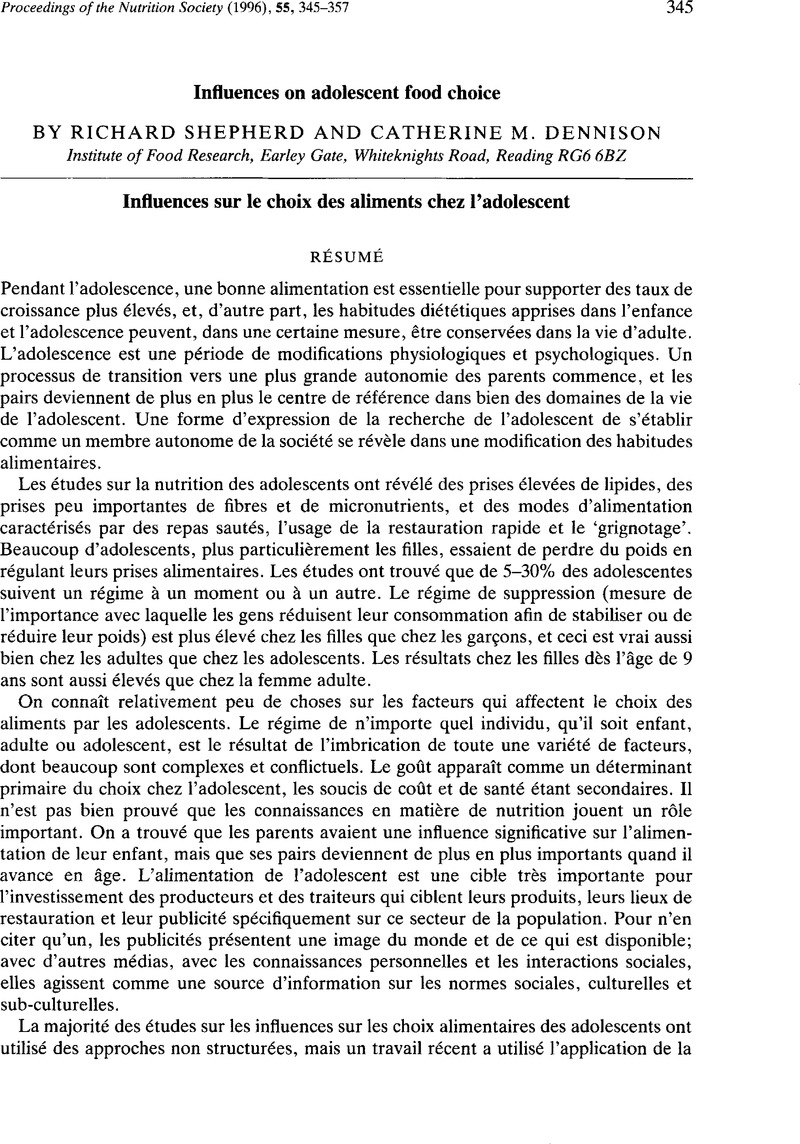Crossref Citations
This article has been cited by the following publications. This list is generated based on data provided by Crossref.
WARWICK, JENNIFER
MCILVEEN, HEATHER
and
STRUGNELL, CHRISTOPHER
1997.
Food choices and the younger generation.
Journal of Consumer Studies & Home Economics,
Vol. 21,
Issue. 2,
p.
141.
Babicz-Zielinska, Ewa
1999.
Food preferences among the Polish young adults.
Food Quality and Preference,
Vol. 10,
Issue. 2,
p.
139.
Warwick, Jennifer
McIlveen, Heather
and
Strugnell, Christopher
1999.
Food choices of 9‐17‐ year olds in Northern Ireland – influences and challenges.
Nutrition & Food Science,
Vol. 99,
Issue. 5,
p.
229.
Hamilton, Jennifer
McIlveen, Heather
and
Strugnell, Christopher
2000.
Educating young consumers – a food choice model.
Journal of Consumer Studies & Home Economics,
Vol. 24,
Issue. 2,
p.
113.
Bissonnette, Madeline Monaco
and
Contento, Isobel R.
2001.
Adolescents' Perspectives and Food Choice Behaviors in Terms of the Environmental Impacts of Food Production Practices: Application of a Psychosocial Model.
Journal of Nutrition Education,
Vol. 33,
Issue. 2,
p.
72.
Frobisher, Clare
and
Maxwell, Sheila M
2001.
The attitudes and nutritional knowledge of a group of 11–12 year olds in Merseyside.
International Journal of Health Promotion and Education,
Vol. 39,
Issue. 4,
p.
121.
Babicz-Zielińska, E.
2001.
Food preferences and choice among the Polish students.
Czech Journal of Food Sciences,
Vol. 19,
Issue. 4,
p.
154.
Åstr⊘sm, Anne Nordrehaug
and
Rise, Jostein
2001.
Young adults' intention to eat healthy food: Extending the theory of planned behaviour.
Psychology & Health,
Vol. 16,
Issue. 2,
p.
223.
Backman, Desiree R.
Haddad, Ella H.
Lee, Jerry W.
Johnston, Patricia K.
and
Hodgkin, Georgia E.
2002.
Psychosocial Predictors of Healthful Dietary Behavior in Adolescents.
Journal of Nutrition Education and Behavior,
Vol. 34,
Issue. 4,
p.
184.
Hart, K. H.
Bishop, J. A.
and
Truby, H.
2002.
An investigation into school children's knowledge and awareness of food and nutrition.
Journal of Human Nutrition and Dietetics,
Vol. 15,
Issue. 2,
p.
129.
Hart, K. H.
Herriot, A.
Bishop, J. A.
and
Truby, H.
2003.
Promoting healthy diet and exercise patterns amongst primary school children: a qualitative investigation of parental perspectives.
Journal of Human Nutrition and Dietetics,
Vol. 16,
Issue. 2,
p.
89.
Flight, Ingrid
Leppard, Phillip
and
Cox, David N
2003.
Food neophobia and associations with cultural diversity and socio-economic status amongst rural and urban Australian adolescents.
Appetite,
Vol. 41,
Issue. 1,
p.
51.
Yannakoulia, M
Karayiannis, D
Terzidou, M
Kokkevi, A
and
Sidossis, L S
2004.
Nutrition-related habits of Greek adolescents.
European Journal of Clinical Nutrition,
Vol. 58,
Issue. 4,
p.
580.
Honkanen, Pirjo
Olsen, Svein Ottar
and
Myrland, Øystein
2004.
Preference‐based segmentation: a study of meal preferences among Norwegian teenagers.
Journal of Consumer Behaviour,
Vol. 3,
Issue. 3,
p.
235.
Mooney, Elaine
Farley, Heather
and
Strugnell, Chris
2004.
Dieting among adolescent females – some emerging trends.
International Journal of Consumer Studies,
Vol. 28,
Issue. 4,
p.
347.
Gustafsson, Inga‐Britt
2004.
Culinary arts and meal science – a new scientific research discipline*.
Food Service Technology,
Vol. 4,
Issue. 1,
p.
9.
Beasley, Lucy J.
Hackett, Allan F.
and
Maxwell, Sheila M.
2004.
The dietary and health behaviour of young people aged 18–25 years living independently or in the family home in Liverpool, UK.
International Journal of Consumer Studies,
Vol. 28,
Issue. 4,
p.
355.
Frobisher, Clare
Jepson, Margaret
and
Maxwell, Sheila M.
2005.
The attitudes and nutritional knowledge of 11‐ to 12‐year‐olds in Merseyside and Northern Ireland.
International Journal of Consumer Studies,
Vol. 29,
Issue. 3,
p.
200.
McKinley, M C
Lowis, C
Robson, P J
Wallace, J M W
Morrissey, M
Moran, A
and
Livingstone, M B E
2005.
It's good to talk: children's views on food and nutrition.
European Journal of Clinical Nutrition,
Vol. 59,
Issue. 4,
p.
542.
Webb, Karen L
Lahti-Koski, Marjaana
Rutishauser, Ingrid
Hector, Debra J
Knezevic, Natalia
Gill, Tim
Peat, Jennifer K
and
Leeder, Stephen R
2006.
Consumption of ‘extra’ foods (energy-dense, nutrient-poor) among children aged 16–24 months from western Sydney, Australia.
Public Health Nutrition,
Vol. 9,
Issue. 8,
p.
1035.



